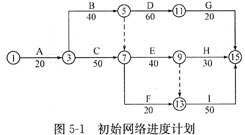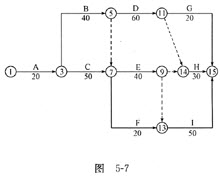问题
问答题
某大型工业项目的主厂房工程,发包人通过公开招标选定了承包人,并依据招标文件和投标文件,与承包人签订了施工合同。合同中部分内容如下:
合同工期160天,承包人编制的初始网络进度计划,如图5-1所示。

由于施工工艺要求,该计划中C、E、I三项工作施工需使用同一台运输机械;B、D、H三项工作施工需使用同一台吊装机械。上述工作由于施工机械的限制只能按顺序施工,不能同时平行进行。
(1) 承包人在投标报价中填报的部分相关内容如下:
①完成A、B、C、D、E、F、G、H、I九项工作的人工工日消耗量分别为:100、400、 400、300、200、60、60、90、1000(工日)。
②工人的日工资单价为50元/工日,运输机械台班单价为2400元/台班,吊装机械台班单价为1200元/台班。
③分项工程项目和措施项目均采用以直接费为计算基础的工料单价法,其中的间接费费率为18%;利润率为7%;税金按相关规定计算。施工企业所在地为县城。
(2) 合同中规定:人员窝工费补偿为25元/工日,运输机械折旧费为1000元/台班,吊装机械折旧费为500元/台班。
在施工过程中,由于设计变更使工作E增加了工程量,作业时间延长了20天,增加用工100个工日,增加材料费2.5万元,增加机械台班20个,相应的措施费增加1.2万元。同时,E、H、I的工人分别属于不同工种,H、I工作分别推迟20天。
对承包人的初始网络进度计划进行调整,以满足施工工艺和施工机械对施工作业顺序的制约要求。
答案
参考答案:
对初始网络进度计划进行调整,结果如图5-7所示。

